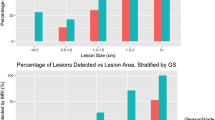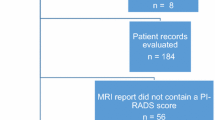Abstract
Objectives
To compare multiparametric magnetic resonance imaging (mpMRI) findings, US-MR fusion prostate biopsy results and whole-mount thin-section histopathology after radical prostatectomy.
Patients and methods
Overall 259 patients, who had undergone mpMRI with lesions reported as PI-RADS 3-5, underwent a MR-US fusion biopsy between 2018 and 2020. Overall 186 biopsies yielded prostate cancer and 104 patients subsequently underwent endoscopic extraperitoneal radical prostatectomy. Histopathology of biopsies was compared to the final histopathology in whole mount thin sections after radical prostatectomy by means of descriptive statistics, and further, the lesions from mpMRT were compared to whole mount histology.
Results
Prostate cancer was diagnosed in 186 (71.8%) of 259 patients (median age 69.2 y, range 42–82 y, median PSA 7.8 ng/ml, range 2.1–31.3 ng/ml). Of those, 95 (51,1%) underwent radical endoscopic prostatectomy, and 80 (43%) chose radiotherapy or active surveillance. In 52/95 (54,7%) with RPE additional lesions were found in the final histological whole mount sections not described at mpMRI. 22/95 (23,2%) of RPE patients had ≥ 1 additional Gleason score ≥ 7 lesions, 23 /259 (8,4%) of biopsies, respectively. The Gleason score after surgery was upgraded in 37/95 (38,9%) and downgraded in 18/95 (18,9%) patients.
Conclusion
If we compare all 259 performed biopsies with the final histological whole mount sections which showed additional lesions with Gleason ≥ 7 (23,2%), it can be assumed that up to 10% of clinical significant carcinomas are missed during primary assessment via mpMRI. The majority of additional findings after RP were intermediate/high risk tumors. Upgrades from low-risk to intermediate or high-risk occurred.


Similar content being viewed by others

References
Brown LC, Ahmed HU, Faria R, El-Shater Bosaily A, Gabe R, Kaplan RS et al (2018) Multiparametric MRI to improve detection of prostate cancer compared with transrectal ultrasound-guided prostate biopsy alone: the PROMIS study. Health Technol Assess Winch Engl 22(39):1–176
Ahmed HU, El-Shater Bosaily A, Brown LC, Gabe R, Kaplan R, Parmar MK et al (2017) Diagnostic accuracy of multi-parametric MRI and TRUS biopsy in prostate cancer (PROMIS): a paired validating confirmatory study. Lancet 389(10071):815–822
Muthigi A, George AK, Sidana A, Kongnyuy M, Simon R, Moreno V et al (2017) Missing the mark: prostate cancer upgrading by systematic biopsy over magnetic resonance imaging/transrectal ultrasound fusion biopsy. J Urol 197(2):327–334
Mohammadian Bajgiran A, Afshari Mirak S, Shakeri S, Felker ER, Ponzini D, Ahuja P et al (2019) Characteristics of missed prostate cancer lesions on 3T multiparametric-MRI in 518 patients: based on PI-RADSv2 and using whole-mount histopathology reference. Abdom Radiol 44(3):1052–1061
Drost FJH, Osses DF, Nieboer D, Steyerberg EW, Bangma CH, Roobol MJ, et al. Prostate MRI, with or without MRI-targeted biopsy, and systematic biopsy for detecting prostate cancer. Cochrane Urology Group, editor. Cochrane Database Syst Rev [Internet]. 2019 Apr 25 [cited 2022 May 21]; Available from: https://doi.wiley.com/https://doi.org/10.1002/14651858.CD012663.pub2
Padhani AR, Weinreb J, Rosenkrantz AB, Villeirs G, Turkbey B, Barentsz J (2019) Prostate imaging-reporting and data system steering committee: PI-RADS v2 status update and future directions. Eur Urol 75(3):385–396
Sonni I, Felker ER, Lenis AT, Sisk AE, Bahri S, Allen-Auerbach M et al (2022) Head-to-head comparison of 68 Ga-PSMA-11 PET/CT and mpMRI with a histopathology gold standard in the detection, intraprostatic localization, and determination of local extension of primary prostate cancer: results from a prospective single-center imaging trial. J Nucl Med 63(6):847–854
Borkowetz A, Platzek I, Toma M, Renner T, Herout R, Baunacke M et al (2016) Direct comparison of multiparametric magnetic resonance imaging (MRI) results with final histopathology in patients with proven prostate cancer in MRI/ultrasonography-fusion biopsy. BJU Int 118(2):213–220
Siddiqui MM, Rais-Bahrami S, Turkbey B, George AK, Rothwax J, Shakir N et al (2015) Comparison of MR/ultrasound fusion-guided biopsy with ultrasound-guided biopsy for the diagnosis of prostate cancer. JAMA 313(4):390
Brisbane WG, Priester AM, Ballon J, Kwan L, Delfin MK, Felker ER et al (2022) Targeted prostate biopsy: umbra, penumbra, and value of perilesional sampling. Eur Urol 82(3):303–310
Epstein JI, Egevad L, Amin MB, Delahunt B, Srigley JR, Humphrey PA (2016). The 2014 International Society of Urological Pathology (ISUP) Consensus Conference on Gleason Grading of Prostatic Carcinoma: Definition of Grading Patterns and Proposal for a New Grading System. Am J Surg Pathol 40(2):244–252
Radtke JP, Schwab C, Wolf MB, Freitag MT, Alt CD, Kesch C et al (2016) Multiparametric magnetic resonance imaging (MRI) and MRI–transrectal ultrasound fusion biopsy for index tumor detection: correlation with radical prostatectomy specimen. Eur Urol 70(5):846–853
Ito K, Furuta A, Kido A, Teramoto Y, Akamatsu S, Terada N et al (2020) Detectability of prostate cancer in different parts of the gland with 3-Tesla multiparametric magnetic resonance imaging: correlation with whole-mount histopathology. Int J Clin Oncol 25(4):732–740
Park KJ, Kim M hyun, Kim JK, Cho KS (2019) Characterization and PI-RADS version 2 assessment of prostate cancers missed by prebiopsy 3-T multiparametric MRI: correlation with whole-mount thin-section histopathology. Clin Imaging 55:174–80
Temel CM, Ediz C, Akan S, Ozer E, Yilmaz O (2020) Association of Gleason score with PSA values and serum testosterone levels measured prior to prostate biopsy. J Coll Physicians Surg Pak 30(4):399–402
Thompson IM, Pauler DK, Goodman PJ, Tangen CM, Lucia MS, Parnes HL et al (2004) Prevalence of prostate cancer among men with a prostate-specific antigen level ≤4.0 ng per milliliter. N Engl J Med 350(22):2239–2246
Sfoungaristos S, Perimenis P (2012) PSA density is superior than PSA and Gleason score for adverse pathologic features prediction in patients with clinically localized prostate cancer. Can Urol Assoc J J Assoc Urol Can 6(1):46–50
Walz J, Haese A, Scattoni V, Steuber T, Chun FKH, Briganti A et al (2008) Percent free prostate-specific antigen (PSA) is an accurate predictor of prostate cancer risk in men with serum PSA 2.5 ng/mL and lower. Cancer 113(10):2695–2703
Guazzoni G, Nava L, Lazzeri M, Scattoni V, Lughezzani G, Maccagnano C et al (2011) Prostate-specific antigen (PSA) isoform p2PSA significantly improves the prediction of prostate cancer at initial extended prostate biopsies in patients with total PSA between 2.0 and 10 ng/ml: results of a prospective study in a clinical setting. Eur Urol 60(2):214–22
Junker D, Quentin M, Nagele U, Edlinger M, Richenberg J, Schaefer G et al (2015) Evaluation of the PI-RADS scoring system for mpMRI of the prostate: a whole-mount step-section analysis. World J Urol 33(7):1023–1030
Bratan F, Niaf E, Melodelima C, Chesnais AL, Souchon R, Mège-Lechevallier F et al (2013) Influence of imaging and histological factors on prostate cancer detection and localisation on multiparametric MRI: a prospective study. Eur Radiol 23(7):2019–2029
Stabile A, Giganti F, Kasivisvanathan V, Giannarini G, Moore CM, Padhani AR et al (2020) Factors influencing variability in the performance of multiparametric magnetic resonance imaging in detecting clinically significant prostate cancer: a systematic literature review. Eur Urol Oncol 3(2):145–167
Chaloupka M, Bischoff R, Pfitzinger P, Lellig E, Ledderose S, Buchner A, et al (2019) Detection of Gleason 6 prostate cancer in patients with clinically significant prostate cancer on multiparametric magnetic resonance imaging. Wiggermann P, Krüger-Genge A, Jung F, editors. Clin Hemorheol Microcirc 73(1):105–11
Author information
Authors and Affiliations
Corresponding author
Additional information
Publisher's Note
Springer Nature remains neutral with regard to jurisdictional claims in published maps and institutional affiliations.
Rights and permissions
Springer Nature or its licensor (e.g. a society or other partner) holds exclusive rights to this article under a publishing agreement with the author(s) or other rightsholder(s); author self-archiving of the accepted manuscript version of this article is solely governed by the terms of such publishing agreement and applicable law.
About this article
Cite this article
Doblhammer, S., Kinger, P., Starmuehler, M. et al. A comprehensive comparison between mpMRI of the prostate, MR-US fusion biopsy and whole mount histopathology. World J Urol 41, 1055–1060 (2023). https://doi.org/10.1007/s00345-023-04339-6
Received:
Accepted:
Published:
Issue Date:
DOI: https://doi.org/10.1007/s00345-023-04339-6



